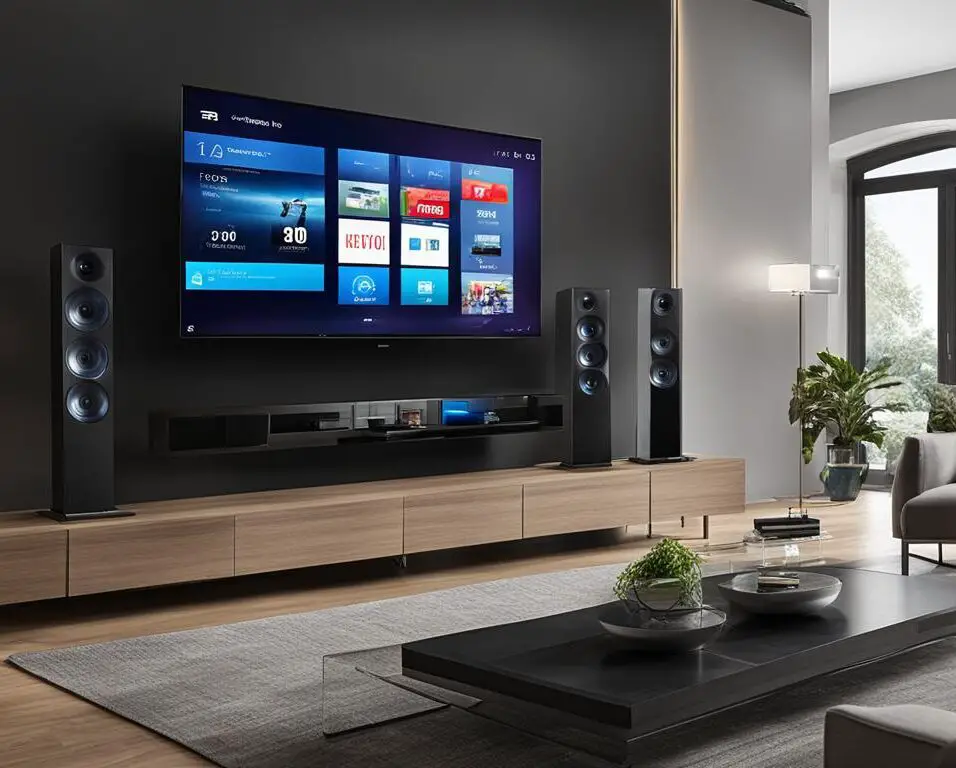Understanding Smart Home Connectivity Options
In today’s interconnected world, smart homes have become increasingly popular. These homes offer a seamless experience by connecting various devices and appliances to the internet, creating a network of convenience, comfort, and energy efficiency. To fully embrace the potential of a smart home, it is crucial to understand the different connectivity options available.
When it comes to smart home connectivity options, there are several key factors to consider. From Wi-Fi to Bluetooth and smart hubs, each option offers unique advantages and considerations. It is also important to choose the right ecosystem for your smart home, such as Google Home, Amazon Alexa, or Apple HomeKit. Moreover, understanding various smart home standards, setting up devices, and troubleshooting tips can ensure a smooth and hassle-free experience.
Key Takeaways:
- Smart homes offer convenience, comfort, and energy efficiency through internet-connected devices and appliances.
- Connectivity options include Wi-Fi, Bluetooth, and smart hubs.
- Choosing the right ecosystem, such as Google Home, Amazon Alexa, or Apple HomeKit, is essential for seamless integration.
- Understanding smart home standards, device setup, and troubleshooting can enhance the smart home experience.
- Wireless home automation enables the control of devices and appliances from anywhere within the home.
The Importance of Wi-Fi in Smart Home Connectivity
In the world of smart home connectivity, a reliable Wi-Fi connection plays a critical role in ensuring the seamless operation of IoT devices. With the increasing number of connected devices in a smart home, such as smart speakers, thermostats, and security cameras, a robust Wi-Fi network becomes essential to control and monitor these devices remotely.
Wi-Fi operates on different frequencies, most commonly the 2.4 GHz and 5 GHz bands. The 2.4 GHz frequency offers a longer range but slower speeds, while the 5 GHz frequency provides faster speeds but a shorter range. It is important to understand the capabilities of both frequencies and choose the most suitable one for your smart home devices.
One technology that promises improved Wi-Fi performance is Wi-Fi 6E, which supports the 6 GHz band. Wi-Fi 6E brings faster speeds, better device handling, and increased security for smart home connectivity. With Wi-Fi 6E, your smart devices can communicate more efficiently, resulting in smoother automation and enhanced user experience.
However, Wi-Fi congestion can sometimes hinder the performance of smart home devices, particularly in densely populated areas or apartment buildings. To overcome this challenge, you can optimize your Wi-Fi network by using different channels or upgrading to a newer router that supports the latest Wi-Fi standards.

Additionally, the placement of your Wi-Fi router can significantly impact the signal strength and coverage within your smart home. It is recommended to position the router in a central location and away from obstacles to maximize Wi-Fi coverage. For larger properties, a mesh Wi-Fi system can be considered to eliminate dead zones and ensure consistent connectivity throughout the entire home.
Lastly, security is a key concern when it comes to smart home connectivity. Protecting your Wi-Fi network with a strong password and enabling features like network encryption can help safeguard your smart home devices from potential hacking or unauthorized access.
In conclusion, a reliable Wi-Fi connection is essential for the smooth operation of smart home devices. Considering the right frequency, optimizing Wi-Fi network settings, and prioritizing security measures will ensure a seamless and secure smart home experience.
Choosing the Right Ecosystem for Your Smart Home
When it comes to setting up a smart home, one of the crucial decisions you’ll need to make is selecting the right ecosystem. The most popular options in the market today are Google Home, Amazon Alexa, and Apple HomeKit, each offering its unique features and benefits.
If you opt for Google Home, you’ll enjoy the renowned Google Assistant, known for its fast response time and ability to understand complex commands. With its conversational style, Google Assistant makes interacting with your smart devices a breeze.
On the other hand, Amazon Alexa boasts the widest range of compatible products and supports a vast array of skills developed by third parties. Additionally, Amazon offers budget-friendly smart speakers and displays, making it an attractive choice for many smart homeowners.
For iPhone owners, Apple HomeKit is a top-notch option. It ensures seamless integration and exceptional security, providing peace of mind when it comes to protecting your smart home. Apple HomeKit offers a seamless experience for controlling your smart devices within the Apple ecosystem.
While it’s recommended to choose one main ecosystem for easier integration and control, there are alternative options like Home Assistant, Samsung’s SmartThings, and Tuya’s Smart Life. These alternatives may appeal to users seeking specific features and integrations to enhance their smart home experience.
FAQ
What are the different connectivity options available for smart home systems?
Smart home systems can connect via Wi-Fi, Bluetooth, or smart hubs.
Why is a reliable Wi-Fi connection important for smart home devices?
A reliable Wi-Fi connection ensures effective operation of most smart home devices.
What are the different Wi-Fi frequencies used in smart home connectivity?
Smart home devices typically use the 2.4 GHz and 5 GHz frequencies, with the latter offering faster speeds.
What is Wi-Fi 6E and why is it important for smart homes?
Wi-Fi 6E is a newer protocol that supports the 6 GHz band, offering faster speeds, better device handling, and increased security.
How can Wi-Fi congestion be mitigated in a smart home?
Wi-Fi congestion can be mitigated by using different channels or upgrading to a newer router.
What should I consider when setting up a smart home ecosystem?
It’s important to choose an ecosystem that suits your needs, such as Google Home, Amazon Alexa, or Apple HomeKit.
What are the strengths of Google Home, Amazon Alexa, and Apple HomeKit?
Google Home offers a fast response and conversational style, Amazon Alexa has a wide range of compatible products and third-party skills, and Apple HomeKit ensures smooth operation and high security.
Can I use alternative ecosystems for my smart home?
Yes, alternative ecosystems like Home Assistant, Samsung’s SmartThings, and Tuya’s Smart Life offer different features and integrations.








